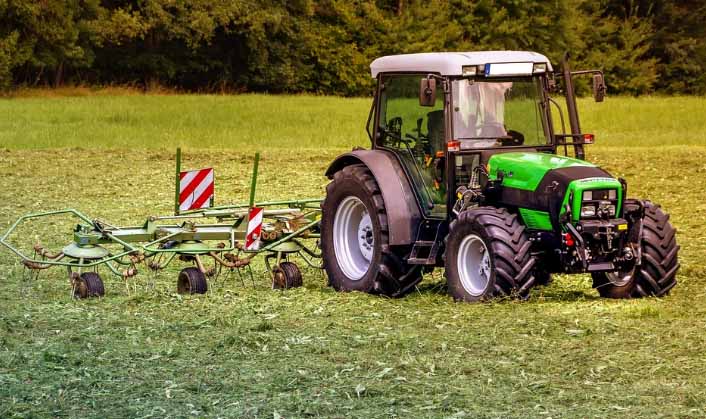One of the largest investments a grower can make is a tractor. But competent machinery managers can manage tractor and power costs per acre with a few straightforward calculations. You can choose when to buy new tractors and when to trade in by knowing precisely what costs per acre will be from year to year.
What To Look For In Tractors
In 2022, you should budget $8,500—$75,300 when purchasing a tractor. It may also be necessary to pay an additional fee of up to $3,100 for attachment.
What You Need To Know is as follows: The truth is that there are a wide variety of tractor sizes and types, and these variables will have a significant impact on the cost you can anticipate paying. To perform a wide variety of outdoor tasks, a good tractor can act as an all-purpose tool that is incredibly versatile. You can connect a variety of attachments to your vehicle to perform tasks ranging from snow removal to hole digging.
Compare Prices On Tractors In Your Area
How much power do I need? should be the first question you consider when looking for a tractor.” Your tractor’s horsepower rating will let you know how capable it is of handling very demanding tasks. A small tractor has about 25 horsepower and is priced at the low end of the spectrum. These are compact utility tractors that can help with the upkeep of a sizable yard or garden. The industrial tractors, which are used in commercial farming operations and have engines with 100 horsepower or more, are at the other end of the spectrum. Depending on how many accessories and extra features you need, these units can cost well over $60,000.
The types of tools and attachments that work with your tractor are another crucial consideration. Although equipment from different brands typically functions well together, there are some benefits to using equipment from the same manufacturer. Sometimes, it makes sense to evaluate your needs in relation to the attachments that are offered.
Finally, make sure the model you choose is widely used and has good support and parts availability. When making your initial purchase, you might be able to save a few dollars by choosing an obscure tractor model that appears to be a great deal. It will be the kind of decision that haunts you once something breaks down for the first time and you have no practical way to get your tractor fixed.
What Are The Prices Of The New Tractors?
You can pick from literally hundreds of tractors, ranging from small residential models to powerful heavy-duty vehicles with more than 300 horsepower. After choosing a model, you’ll also have to make a decision from a wide range of features and options.
Tractors are typically four-wheel drives in the vast majority of cases. When compared to two-wheel drive models, four-wheel drive tractors offer better traction, making them essential if you intend to use front attachments like loaders. Only if you’ll be doing a lot of driving at highway speeds are two-wheel drive models better.
Tractors with closed cabs are more common than those without. The cost of a tractor with an enclosed cab is higher, but it provides the driver with more comfort and shielding from the sun, wind, rain, and snow. The resale value of cab-equipped tractors is also higher. Cabs are much less typical on compact tractors, though.
How Much Does A Farm Tractor Cost On Average?
It’s similar to asking how much food a teenager will eat to inquire about the average cost of a farm tractor. Although it might vary from day to day and depend on the particulars, you can be sure that it will be a lot in general. Depending on the setup you require, the tractor’s use history, the quality of maintenance, and the accessibility of replacement parts in your area, purchasing even a small used tractor can become expensive.
- Mid-size tractors with 30 to 75 hp usually cost anywhere from $25,000 to $50,000.
- Larger tractors with about 100 hp, 4-wheel drive and a cab tend to run $50,000 to $75,000.
- Tractors with 100 to 150 hp usually cost anywhere from $75,000 to $150,000.
While we may not be able to provide you with the exact average cost of the tractor you have in mind, we can share some frequently asked questions and our responses with you to help you understand the range of prices for both new and used farm tractors.
Tractor Additional Attachment Costs
You require more than just a tractor. The best course of action would be for you to consider purchasing some attachments as well. Therefore, keep in mind to factor a buffer for them into the amount you borrow.
There are many different kinds of accessories to buy, depending on the purpose of your tractor. Just a few of the typical ones are as follows:
- Backhoe attachments typically cost between $4,500 and $7,000.
- In contrast, loader attachments can range in price from $3,000 to $6,000.
- Rakes typically range in price from $400 to $1,000.
- Finally, if four-wheel drive is not standard, it is a good modification. A typical 4WD conversion will cost around $5,000.

What Elements Influence The Price Of A Tractor?
Frequently, a number of variables affect the cost of a new tractor and its accessories.
New vs. Used Models
Looking at the list we created earlier, it is clear that age is important when talking about price. The year of manufacture is not the only factor. We’re also discussing the business’s hours of operation. In essence, newer, less-used machinery is more expensive than older tractors. The amount of structural damage sustained by the tractor is one factor in this. And in part because of how much work the engine has already done. The operating hours have the biggest impact overall.
Having said that, the problem of finding replacement parts cannot be avoided, even if you treat your old tractor with the same tender care that you would give to your grandmother. Let’s say you’ve been maintaining an old tractor for years, and now one of the parts is needed because it has finally worn out. In that case, you might discover that the tractor’s manufacturer stopped making it and stopped making the spare parts. The next difficult task is to look for a spare part from a scrapped tractor or to pay a premium for a local engineering firm to make one for you. In either case, it might be wiser to occasionally replace your tractor with a more modern model.
Power & Size
These two elements are most likely among the most crucial. The power of a tractor engine is typically measured in horsepower (HP) in the USA. However, if the tractor is an import from another nation, its power may be expressed in kW. How easily the tractor can handle challenging, heavy-duty jobs depends on the horsepower rating of the vehicle. At the low end of the price range is a sub-compact tractor with a power of approximately 25HP. They can be equipped with earthmoving attachments or grass-mowing gear and are useful for maintaining a sizable garden. Large tractors with engines over 100 HP, on the other hand, will be at the top of the price range when used in commercial farming applications. The larger tractors have a lot more accessories than the smaller tractors, which increases their utility.
The types of tasks a tractor can perform depend on its physical size. For small-scale construction projects or gardening, a small utility tractor is ideal. These commonly include slope grading, mowing, brush cutting, post hole digging, and towing a small loaded trailer. Additionally, you might be able to perform a variety of other tasks like front-end loading, snow removal, and many others. In addition, a growing number of jobs use the tractor’s size and weight as a counterbalance as it grows physically bigger and heavier. Large-scale load moving, backhoe work, and other tasks that require friction with the ground are all made much simpler by its heavier weight.
Tractor Uses
When internal combustion engines became widely used, heavy-duty farm work was transitioned away from teams of horses or oxen. Previously, temperamental and clunky steam-driven tractors coexisted peacefully with beasts of burden. You couldn’t beat a horse for getting the job done on a farm, even between the First and Second World Wars, when gasoline-powered cars became more prevalent. They wouldn’t malfunction or get mired in the muck. Additionally, the farmer didn’t have to buy fuel. However, mechanization of farming in Europe and North America spread after 1945. However, aside from remote areas close to cities, farms in South America, Asia, and Africa largely continued to use beasts of burden due to smallholder farmers.
Track or wheeled tractors
There are situations where using tracked tractors is preferable to using wheeled ones. In many situations where a wheeled model couldn’t, tractors with caterpillar tracks can help by providing enough friction with the ground. These jobs include clearing land, moving heavy objects, removing snow, working on slopes, reaching inaccessible rocky terrain, and working on wet and muddy surfaces. There are a few drawbacks to using a track tractor, though. A tracked vehicle will deteriorate road surfaces, unlike a wheeled model that can move along public roads. Along with using a lot of fuel, it will move much more slowly than other vehicles on the road.
If you think it would be cool to purchase a track tractor just because it looks cool. Think again; you’ll discover that it’s a more expensive choice. Many tracked tractors sell for between $300,000 and $600,000. It’s also more difficult to use than a wheeled option unless you plan to use it in the conditions it was designed for. If you wanted to clear a large area of tree stumps before building a new house, you might use a track tractor instead of mowing your garden grass.
Is It Worth It To Buy A New Tractor?
If the tractor you buy will satisfy your needs for a period longer than six years, the investment in a new tractor will be worthwhile. The reason for this is that you would be able to deduct all or the majority of the purchase price from your taxes during that time period in most tax jurisdictions.
Having said that, you also need to think about the overall cost of buying a new tractor, such as financing fees. The best option for you would be a used tractor if the cost of a new tractor would put an excessive strain on your finances or if you think your needs will change soon.
Conclusion
If you do decide to resell your used equipment, your best course of action is to do it online because there are more potential buyers there than there are if you just try to sell it to your local dealership.
Another huge advantage is that you don’t need to schedule an appointment or be concerned about staff making mistakes like they might at a dealership because you can complete all of this work from the convenience of your own home or office.











